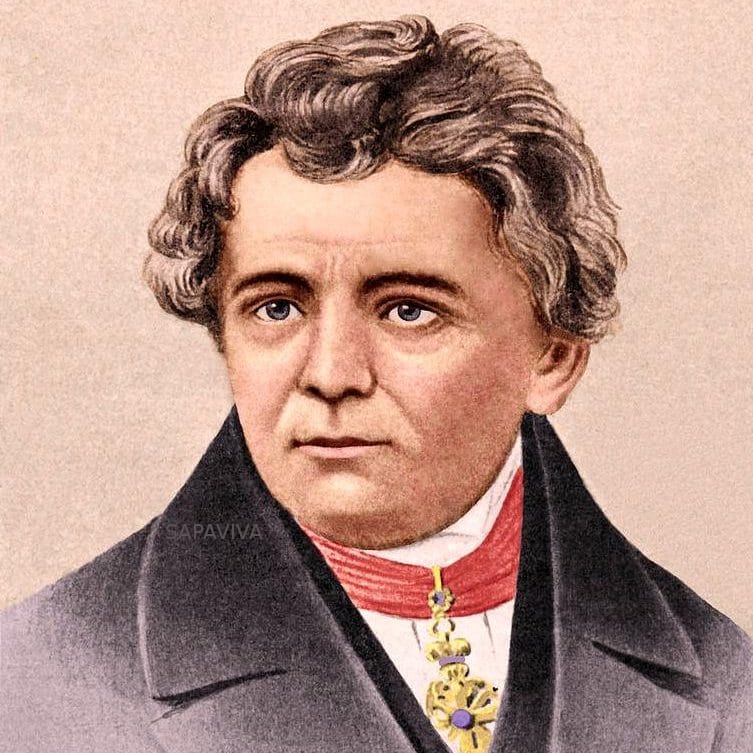Hey there! Ever heard of Georg Simon Ohm? You know, the guy behind the famous Ohm’s Law? Well, buckle up because there’s a lot more to him than just that equation we all know and love (or maybe love to hate). In this article, we’ll dig into the surprising adventures, unexpected experiments, and groundbreaking insights that made Ohm a true pioneer in the world of electricity. Get ready to have your mind blown!
Surprising Facts About Georg Simon Ohm
We all know the name “Ohm”—it’s like the foundation of everything electrical. But the man behind the famous Ohm’s Law, Georg Simon Ohm, was more than just a name in a textbook. He was a dedicated educator, a meticulous researcher, and a true pioneer in understanding electricity.
Here are some surprising facts about him:
- Ohm’s first love wasn’t electricity—it was math and physics! He was also super passionate about teaching and shared his knowledge with students throughout his career.
- He was also deeply interested in acoustics—the science of sound. Some of his early groundbreaking work was actually in that field, earning him serious recognition before he even tackled electricity head-on.
- When he finally did dive into electricity, Ohm was incredibly thorough. His scientific publications were meticulously crafted, presenting his findings with crystal-clear precision.
- His most famous work, “The Galvanic Circuit Investigated Mathematically,” was a game-changer. It laid out the principles of electrical circuits in a way no one ever had before.
- Groundbreaking discoveries rarely come easy, and Ohm’s Law was no exception. The scientific community didn’t exactly welcome it with open arms when it first came out in 1827. There was skepticism, debate, you name it!
- But Ohm didn’t back down. He believed in his work and knew his experiments were solid. Talk about standing your ground! This resilience and determination eventually led to his findings being widely accepted.
- Ohm’s legacy goes way beyond just one law. His dedication to teaching, his crazy-precise experimental methods—they all left a lasting impact on the scientific community.
- He wasn’t just theorizing—he was a hands-on experimenter! Ohm meticulously measured resistance, voltage, and current, laying the groundwork for how electrical engineering is done today.
- And let’s not forget his passion for teaching. Ohm inspired countless students, passing on his love for science and pushing the boundaries of knowledge.
So, the next time you see Ohm’s Law, remember the man behind it! Georg Simon Ohm’s story reminds us that sometimes, the most groundbreaking discoveries come from daring to explore the unknown.
If you’re looking for some interesting trivia, check out these facts about Mario Kempes. Or if you’re interested in learning more about business, you should read these surprising facts about Jorge Paulo Lemann.
What are some interesting facts about Ohm?
- Ohm’s Law wasn’t immediately embraced. It’s hard to imagine, but some scientists back then didn’t believe it! It took years for others to confirm his findings before they realized just how important Ohm’s Law really was.
- Ohm wasn’t just interested in electricity. He was fascinated by sound, too! In fact, he was way ahead of his time in figuring out the math behind how sound waves work—an area of science we now call acoustics.
- Ohm lived during an exciting time for scientific discovery. It was an era of groundbreaking findings about how the world worked!
- He was known for being an amazing teacher. People said he could explain complex scientific stuff in a way that just made sense. Talk about a gift!
- Ohm’s inspiration for Ohm’s Law came from a surprising source: water pipes! He noticed how the speed of water changed depending on the pressure or the width of the pipe. It’s mind-blowing how he connected that to electricity.
- Experimenting with electricity back then wasn’t as common as it is now. Ohm was a true trailblazer, super careful about how he set up his experiments and always laser-focused on taking precise measurements. That attention to detail was key to his success.
- Imagine a world without smartphones, the internet, or even electric lights. Ohm’s work was a crucial early step that made all of these technologies possible. He really did lay the foundation for how we use electricity to power our modern world.
Key Takeaways:
- Ohm’s Law isn’t just some boring equation; it’s a fundamental principle that helps us understand how electricity behaves.
- Ohm was a man of many talents, making significant contributions not just to electricity but also to the study of sound.
- He wasn’t just a brilliant scientist; he was a gifted teacher who ignited a passion for science in countless others.
- The next time you flip on a light switch, remember Ohm! His work paved the way for so many of the technologies we take for granted today.
What were the discoveries of Georg Ohm?
Georg Ohm wasn’t just messing around in the lab—this guy made some serious discoveries. Let’s take a closer look at the cool stuff he figured out:
- Ohm’s Law: This is the big one. Imagine a hose with water running through it. The amount of water flowing is like the current in an electrical circuit. The pressure pushing the water is like the voltage. And anything that makes it harder for the water to flow, like a kink in the hose, is like resistance. Ohm’s Law basically says that voltage, current, and resistance in a circuit are all related. If you change one, the others change too, in a predictable way. Pretty neat, huh?
- Electrical Conductivity: Ohm was fascinated by how well different materials conduct electricity. You know how some things, like metal, let electricity flow through them easily, while others, like rubber, totally block it? Ohm was one of the first scientists to really study this. His work helped us figure out which materials are best for making things like wires and insulators—super important stuff for building all kinds of electrical devices!
- Ohm’s Acoustic Law: This one might surprise you! Ohm came up with a law that describes how the intensity of a sound wave changes depending on its wavelength and frequency. It’s a bit technical, but essentially, it helps us understand how sound travels and why we hear things the way we do.
- Early Explorations in Optics: While not as well-known for his work with light, Ohm was curious about it, too! He explored some of the fundamental principles of light waves, which helped pave the way for later scientists to make groundbreaking discoveries in the field of optics.
It’s important to remember that our understanding of these concepts has continued to evolve since Ohm’s time. Researchers are constantly refining and expanding upon these ideas, and there’s always more to learn!
What experiments did Ohm do?
Georg Simon Ohm was a true pioneer. Back in the early 1800s, the world was buzzing about this newfangled thing called electromagnetism. A scientist named Oersted had just discovered that electricity could actually create magnetic fields—mind-blowing stuff! Ohm was totally captivated by this and knew he had to investigate further.
Being a bit of a DIY enthusiast, Ohm built a lot of his own equipment. Using his homemade setup, he started running electricity through wires of different lengths. He discovered that the longer the wire, the weaker the electromagnetic force got. This was a huge clue, and it got him thinking about the relationship between these forces and something called resistance.
Resistance is basically how much a material resists the flow of electricity. Think of it like trying to push water through a pipe—a narrow pipe offers more resistance than a wide one. Ohm figured that resistance was a key player in how electricity worked.
So, he took his experiments to the next level. Ohm meticulously measured the voltage (the “push” behind the electricity), the current (the actual flow of electric charge), and the resistance in his circuits. After tons of experiments and probably a few blown fuses, he discovered the groundbreaking relationship we now call Ohm’s Law.
Ohm’s Law basically says that:
- More voltage means more current.
- More resistance means less current.
It’s a fundamental principle that governs how all electrical circuits work, from the ones in your smartphone to the massive ones powering entire cities.
But Ohm didn’t stop there! He was also fascinated by sound and made important contributions to the field of acoustics, studying how sound waves travel and interact with matter.
What’s truly impressive about Ohm’s work is how incredibly thorough and meticulous he was. He didn’t just throw some wires together—he carefully built his equipment, controlled his experiments, and rigorously analyzed his data. His dedication to scientific rigor set a high bar for future researchers and paved the way for the amazing technological advancements we enjoy today.
So, the next time you turn on your computer or scroll through your phone, remember to thank Georg Simon Ohm and his dedication to unraveling the mysteries of electricity.
How did Ohm discover his law?
Ohm was completely fascinated by electromagnetism. After all, another scientist named Oersted had just made some mind-blowing discoveries with compass needles and wires. Inspired, Ohm set up his own experiments using a compass needle to measure the electromagnetic force coming from wires of different lengths.
He noticed something peculiar: the longer the wire, the weaker the force seemed to be. This got him thinking hard about how electricity actually travels through these wires.
Ohm knew he needed to be super precise with his experiments. So, he built his own equipment to carefully control the voltage and measure the current flowing through different wires. He meticulously recorded everything, making sure there were no mistakes.
After analyzing tons of data, he discovered something amazing: the current flowing through a wire wasn’t random at all! It was directly related to the voltage, but it also depended on how much resistance the wire put up against that flow.
Imagine trying to push a crowd of people through a narrow doorway:
- The more people you try to push through (voltage), the more people will squeeze through (current),
- But a really narrow doorway (resistance) will always limit how many can get through, no matter how hard you push.
This was huge! Ohm had stumbled upon a clear, predictable pattern that could be written down as a simple mathematical formula—what we now call Ohm’s Law.
Of course, not everyone believed him right away. Scientists can be a skeptical bunch! But his experiments were solid, and eventually, people started to see how important his discovery truly was. It completely changed the way we think about electrical circuits and paved the way for all the incredible electrical gadgets we use today.
And that’s not all Ohm did! He went on to explore how sound waves work, even developing something called Ohm’s acoustic law, which explains how loud a sound is based on how strong its vibrations are. He even dabbled in the world of light, contributing to our understanding of optics!
Georg Ohm’s work was truly game-changing. His legacy lives on not just in the laws of physics that bear his name but in every single electrical device we use. The next time you flip on a light switch, remember the guy who figured out how it all works, thanks to his meticulous experiments and insatiable curiosity.
Why is Ohm’s Law so powerful?
We know Ohm’s Law is a big deal in the world of electronics, but why? Imagine trying to build a house without knowing how much weight a beam can hold or how to calculate the slope of a roof—it would be a disaster! That’s kind of what it’s like trying to work with electricity without understanding Ohm’s Law.
Think of Ohm’s Law as the instruction manual for electricity. It tells us:
- The amount of electrical current flowing through something (like a wire) is directly related to the voltage (the “push” of electricity) and inversely related to the resistance (how much the material tries to stop the flow).
Think of it like a water hose:
- Voltage: The water pressure. Higher pressure = more water flowing.
- Resistance: The width of the hose. A narrow hose restricts water flow, while a wider one allows more water through.
- Current: The amount of water flowing through.
Ohm’s Law lets us calculate exactly how much water will flow based on the pressure and hose width.
Here’s why that’s so powerful:
- No More Guesswork: Ohm’s Law gives us a precise mathematical formula (Voltage (V) = Current (I) x Resistance (R)). This means engineers can design circuits with specific and predictable outcomes. No more crossing their fingers and hoping for the best!
- Troubleshooting Pros: Imagine your lamp suddenly stops working. With Ohm’s Law, you can measure the voltage and resistance in the circuit and pinpoint the problem. Maybe the bulb is blown (increased resistance), or there’s a break in the wire (interrupting current flow).
- Beyond Wires and Circuits: Ohm’s Law principles apply to more than just electricity. Scientists and engineers use similar concepts to understand things like:
- Fluid dynamics (how liquids flow)
- Heat transfer
- Even sound waves.
- Constantly Evolving: While Ohm’s Law is a cornerstone of electrical engineering, it’s not set in stone. Researchers are always working to understand its limitations and how it applies in different and extreme situations. For example, at extremely high frequencies or with certain materials, Ohm’s Law might not perfectly predict what happens. Investigating these exceptions pushes the boundaries of our understanding of electricity and leads to new technologies.
To put it simply: Ohm’s Law is like the Rosetta Stone of electricity! It helps us understand, predict, and manipulate this powerful force, making everything from our smartphones to our homes possible.
Why is ohm called ohm?
Ever wonder why electrical resistance is measured in “ohms?” It’s not some random sound effect—it’s named after Georg Simon Ohm, the German physicist who basically cracked the code of electricity back in the 1800s.
Ohm was obsessed with figuring out how electricity worked. He spent ages experimenting with circuits, trying to understand how the flow of electricity, the voltage, and this thing called resistance all fit together. And guess what? He figured it out!
Let’s break it down using the water hose analogy again:
- Electrical current: The amount of water flowing through the hose.
- Voltage: The pressure pushing the water.
- Resistance: How narrow the hose is. A narrow hose makes it harder for water to flow.
Ohm’s Law gave us the mathematical formula to explain this relationship. It’s the rulebook for understanding how electricity behaves in circuits. And because his discovery was such a big deal, we decided to name the unit of electrical resistance after him: the ohm.
So next time you see the word “ohm,” remember: it’s not just a random word—it’s a tribute to the guy who helped us unlock the secrets of electricity.
What is the full name of ohm?
We’ve been tossing around the term “ohm” like it’s an old friend. But have you ever wondered, “Who was this Ohm guy, anyway?” His full name was Georg Simon Ohm, and he wasn’t just some random dude hanging out in a circuit board—he was a big deal in the world of physics and math back in the 19th century. Consider him the Sherlock Holmes of electricity, always hot on the trail of how it works!
Georg Simon Ohm’s claim to fame? Figuring out Ohm’s Law. This law is like the golden rule of electricity, explaining how the amount of electric current flowing through something is directly related to:
- The voltage: That’s the electrical “push.”
- The resistance: How much the thing fights back against the flow.
It’s a pretty big deal, kind of like discovering the rules of the road—but for electricity!
Ohm wasn’t a one-trick pony, though. He was a true renaissance man of science! He made huge advances in understanding how electrical circuits work and how electricity moves. Without his work, we might still be in the dark ages when it comes to things like phones, computers, and even light bulbs!
To honor this electrical genius, the unit of electrical resistance was named after him—the “ohm,” represented by the symbol Ω. It’s like a permanent shout-out in the world of science for his groundbreaking contributions.
How Big is an Ohm?
We’ve talked about the history and impact of the ohm, but have you ever stopped to think about how big an ohm actually is? It might seem like a simple question, but the answer is surprisingly mind-boggling!
We can measure ohms with instruments, but picturing their actual size is tricky. Think of it this way:
- Imagine a tiny gap, as wide as a single atom.
- Fill that gap with a material that resists the flow of electricity (like rubber or glass).
- The resistance that a lone electron would encounter squeezing through that minuscule barrier? That’s roughly equivalent to one ohm.
Let that sink in—a single ohm represents the combined resistance of trillions upon trillions of atoms! It’s a massive number, highlighting how significant even tiny amounts of resistance can be in electrical circuits. It’s a testament to the power of accumulative effects—even the smallest obstacles, multiplied on a massive scale, can have a huge impact!
Don’t forget the brilliant Georg Simon Ohm, who dedicated years to unraveling the mysteries of electricity! His meticulous experiments and groundbreaking discoveries, especially Ohm’s Law (V=IR), provided the foundation for our modern understanding of electrical circuits.
Why is Ohm’s Law Interesting?
Ohm’s Law is like having a magic decoder ring for electrical circuits. It’s simple, yet powerful because it helps us understand how electricity behaves.
Think of it like a water hose:
- Voltage: Water pressure (higher pressure = more water flow)
- Current: Amount of water flowing
- Resistance: How narrow the hose is (narrower hose = less water flow)
Ohm’s Law tells us that:
- Increasing the pressure (voltage) increases water flow (current).
- Making the hose narrower (increasing resistance) reduces water flow, even if the pressure is high.
Here’s why Ohm’s Law is so cool:
- It’s like detective work for circuits! Let’s say a light bulb isn’t working. By measuring the voltage and the current, we can use Ohm’s Law to calculate the resistance. If the resistance is higher than it should be, the bulb’s filament might be broken.
- It’s foundational! Ohm’s Law is the starting point for understanding more complex electrical concepts. For example, “Kirchhoff’s Laws,” which are used to analyze really complicated circuits, are based on Ohm’s Law! Even when dealing with more advanced stuff like alternating current (AC), Ohm’s Law still helps us make sense of it all.
In a nutshell, Ohm’s Law is interesting because:
- It’s simple but powerful: Like a universal key, it unlocks the secrets of how electrical circuits work.
- It’s practical: Engineers use it every day to design everything from smartphones to spaceships.
- It’s foundational: It’s the basis for understanding more complex electrical principles.
Sometimes the most basic ideas can be the most profound!
What does ohm look like?
We can’t see “ohms” directly, but they’re there, hidden within every wire and gadget, influencing how electricity flows. Imagine your garden hose: the wider the hose, the easier it is for the water to flow. Resistance, measured in ohms, is like the narrowness of the hose for electricity.
How do we measure this “narrowness”? That’s where Ohm’s Law comes in handy. This law tells us:
- Voltage (the electrical “push”) equals Current (the amount of electricity flowing) multiplied by Resistance (those ohms!).
This means:
- If the voltage stays the same and the resistance is high (like a narrow hose), the current will be weak.
- Conversely, low resistance (a wide hose) lets the current flow strongly.
To measure ohms, we use a tool called a multimeter. It’s like the Swiss Army knife of the electrical world—it measures voltage, current, and, of course, resistance. Just dial it to the ohms setting, touch the probes to your electrical component (like a wire), and bam—the screen tells you how many ohms of resistance you’ve got!
Here’s where it gets really interesting: scientists are still exploring how resistance works at the tiniest levels, like with electrons zipping around atoms. There’s ongoing debate about the best ways to model and predict resistance in complex materials. So, while we’ve got a good handle on ohms for everyday use, the quest to fully unravel their secrets continues!












